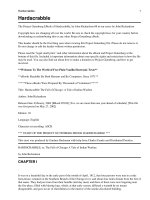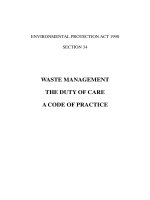Law, Legitimacy and the Rationing of Healthcare A Contextual and Comparative Perspective docx
Bạn đang xem bản rút gọn của tài liệu. Xem và tải ngay bản đầy đủ của tài liệu tại đây (1.09 MB, 268 trang )
This page intentionally left blank
Law, Legitimacy and the Rationing of Healthcare
A Contextual and Comparative Perspective
Keith Syrett argues for a reappraisal of the role played by public law
adjudication in questions of healthcare rationing. As governments
worldwide turn to strategies of explicit rationing to manage the
mismatch between demand for and supply of health services and
treatments, disappointed patients and the public have sought to contest
the moral authority of bodies making rationing decisions. This has led to
the growing involvement of law in this field of public policy. The author
argues that, rather than bemoaning this development, those working
within the health policy community should recognise the points of
confluence between the principles and purposes of public law and the
proposals which have been made to address rationing’s ‘legitimacy
problem’. Drawing upon jurisprudence from England, Canada and
South Africa, the book evaluates the capacity of courts to establish the
conditions for a process of public deliberation from which legitimacy for
healthcare rationing may be derived.
DR KEITH SYRETT is a Solicitor and Senior Lecturer in Law at the
University of Bristol.
Cambridge Law, Medicine and Ethics
This series of books was founded by Cambridge University Press with
Alexander McCall Smith as its first editor in 2003. It focuses on the law’s
complex and troubled relationship with medicine across both the devel-
oped and the developing world. In the past twenty years, we have seen in
many countries increasing resort to the courts by dissatisfied patients
and a growing use of the courts to attempt to resolve intractable ethical
dilemmas. At the same time, legislatures across the world have struggled
to address the questions posed by both the successes and the failures of
modern medicine, while international organisations such as the WHO
and UNESCO now regularly address issues of medical law.
It follows that we would expect ethical and policy questions to be
integral to the analysis of the legal issues discussed in this series. The
series responds to the high profile of medical law in universities, in legal
and medical practice, as well as in public and political affairs. We seek to
reflect the evidence that many major health-related policy debates in the
UK, Europe and the international community over the past two decades
have involved a strong medical law dimension. Organ retention, embry-
onic stem cell research, physician-assisted suicide and the allocation of
resources to fund health care are but a few examples among many. The
emphasis of this series is thus on matters of public concern and/or
practical significance. We look for books that could make a difference
to the development of medical law and enhance the role of medico-legal
debate in policy circles. That is not to say that we lack interest in the
important theoretical dimensions of the subject, but we aim to ensure
that theoretical debate is grounded in the realities of how the law does
and should interact with medicine and health care.
General Editors
Professor Margaret Brazier, University of Manchester
Professor Graeme Laurie, University of Edinburgh
Editorial Advisory Board
Professor Richard Ashcroft, Queen Mary, University of London
Professor Martin Bobrow, University of Cambridge
Dr Alexander Morgan Capron, Director, Ethics and Health,
World Health Organization, Geneva
Professor Jim Childress, University of Virginia
Professor Ruth Chadwick, Cardiff Law School
Dame Ruth Deech, University of Oxford
Professor John Keown, Georgetown University, Washington, D.C.
Dr. Kathy Liddell, University of Cambridge
Professor Alexander McCall Smith, University of Edinburgh
Professor Dr. Mo´nica Navarro-Michel, University of Barcelona
Marcus Radetzki, Marian Radetzki, Niklas Juth
Genes and Insurance: Ethical, Legal and Economic Issues
978 0 521 83090 4
Ruth Macklin
Double Standards in Medical Research in Developing Countries
978 0 521 83388 2 hardback 978 0 521 54170 1 paperback
Donna Dickenson
Property in the Body: Feminist Perspectives
978 0 521 86792 4
Matti Ha¨yry, Ruth Chadwick, Vilhja´lmur A
´
rnason, Gardar A
´
rnason
The Ethics and Governance of Human Genetic Databases: European
Perspectives
978 0 521 85662 1
Ken Mason
The Troubled Pregnancy, Legal Wrongs and Rights in Reproduction
978 0 521 85075 9
Daniel Sperling
Posthumous Interests: Legal and Ethical Perspectives
978 0 521 87784 8
Law, Legitimacy and the
Rationing of Healthcare
A Contextual and Comparative Perspective
Keith Syrett
CAMBRIDGE UNIVERSITY PRESS
Cambridge, New York, Melbourne, Madrid, Cape Town, Singapore, São Paulo
Cambridge University Press
The Edinburgh Building, Cambridge CB2 8RU, UK
First published in print format
ISBN-13 978-0-521-85773-4
ISBN-13 978-0-521-67445-4
ISBN-13 978-0-511-37880-5
© Keith Syrett 2007
2007
Information on this title: www.cambridge.org/9780521857734
This publication is in copyright. Subject to statutory exception and to the provision of
relevant collective licensing agreements, no reproduction of any part may take place
without the written
p
ermission of Cambrid
g
e University Press.
Cambridge University Press has no responsibility for the persistence or accuracy of urls
for external or third-party internet websites referred to in this publication, and does not
g
uarantee that any content on such websites is, or will remain, accurate or a
pp
ro
p
riate.
Published in the United States of America by Cambridge University Press, New York
www.cambridge.org
paperback
eBook (NetLibrary)
hardback
To the memory of my father and of my mother
Contents
Table of Cases page x
Acknowledgements xiii
1 Introduction 1
2 Why ‘Ration’ Healthcare Resources? 15
3 How Rationing Takes Place 45
4 Rationing and the Problem of Legitimacy 75
5 Rationing and the Courts: Theoretical Perspectives 120
6 Rationing in the Courts: England 159
7 Rationing in the Courts: Canada 179
8 Rationing in the Courts: South Africa 207
9 Conclusion 230
Index 246
ix
Table of Cases
1. Canada
Andrews v. Law Society of British Columbia (1989) 56 DLR
(4th) 1 180
Auton v. British Columbia (Attorney General) (2000) 78 BCLR (3d)
55 (BCSC); (2002) 6 BCLR (4th) 201 (BCCA); [2004] 3 SCR
657 (SCC) 48, 143, 183–4, 189, 190, 192–3
Cameron v. Nova Scotia (Attorney General) (1999) 177 DLR (4th)
611 183, 187, 189–90, 191
Chaoulli v. Que´bec (Attor ney General) [2000] RJQ 786 (SCQ);
[2002] RJQ 1205 (CAQ); [2005] 1 SCR 791 (SCC) 121–2,
184–6, 187, 189, 190, 193–200, 203–6, 228–9, 233, 240, 242
Eldridge v. British Columbia (Attorney General) [1997] 3
SCR 624 182–3, 187, 188, 191–2, 233
Fogo (Town) v. Newfoundland (2000) 23 Admin LR (3d)
138 180
Irwin Toy Ltd v. Que´bec (Attorney General) [1989] 1 SCR
927 187, 195
Lexogest Inc.v.Manitoba (Attorney General) (1993) 101 DLR (4th)
523 180
Newfoundland & Labrador v. Sparkes 2004 NLSCTD 16 184
Prince Edward Island (Minister of Health and Social Services) v.
Morgentaler (1996) 139 DLR (4th) 603 180
Reference re Manitoba Language Rights [1985] 1 SCR 721 201
R v. Mills [1999] 3 SCR 668 200
R v. Oakes [1986] 1 SCR 103 190
RJR Macdonald Inc.v.Canada (Attorney General) [1995] 3 SCR
199 187–8
St Joseph Island Hospital Association v. Plummer Memorial Public
Hospital (1996) 24 OTC 73 179–80
Stein v. Que´bec (Tribunal administratif) [1999] RJQ 2416 181
x
Te´treault-Gadoury v. Canada (Employment and Immigration
Commission) [1991] 2 SCR 22 188
Vriend v. Alberta [1998] 1 SCR 493 182, 200
2. England
Associated Provincial Picture Houses v. Wednesbury Corporation
[1948] 1 KB 223 166, 167, 168, 171, 173, 219, 235, 239
Attorney General of Hong Kong v. Ng Yuen Shiu [1983] 2 AC
629 144
Attorney General v. Ryan [1980] AC 718 167
Council of Civil Service Unions v. Minister for the Civil Service [1985]
1 AC 374 129, 166
International Transport Roth GmbH v. Secretary of State for the Home
Department [2003] QB 728 133
McInnes v. Onslow-Fane [1978] 1 WLR 1520 166
Padfield v. Minister of Agriculture, Fisheries and Food [1968]
AC 997 167
R (on the application of Daly) v. Secretary of State for the Home
Department [2001] 2 AC 532 167
R (on the application of Pfizer Ltd) v. Secretary of State for Health
[2003] 1 CMLR 19 132, 175–6, 177–8, 180, 188, 232
R (on the application of Rogers) v. Swindon NHS Primary Care Trust
and Secretary of State for Health [2006] EWHC 171 (Admin.);
[2006] 1 WLR 2649 (CA)
6, 46, 54, 55, 121, 162, 163, 176–7
R (on the application of Watts) v. Bedford Primary Care Trust [2006]
QB 667 162
R v. Cambridge Health Authority, ex parte B [1995] 1 FLR 1055
(QBD) [1995] 1 WLR 898 (A) 46, 121, 131, 162, 167,
168–71, 173, 174, 175, 177, 191, 199, 214, 232, 235, 239, 244
R v. Central Birmingham Health Authority, ex parte Collier
(unreported) 133, 164–8, 169, 174, 177, 180, 232
R v. Central Birmingham Health Authority, ex parte Walker (1987) 3
BMLR 32 133, 164
R v. Criminal Injuries Compensation Board, ex parte P [1995] 1 WLR
845 129,
132–3
R v. Gaming Board for Great Britain, ex parte Benaim and Khaida
[1970] 2 QB 417 166
R v. Higher Education Funding Council, ex parte Institute of Dental
Surgery [1994] 1 WLR 241 143
R v. Ministry of Defence, ex parte Murray [1998] COD 134 143
R v. Ministry of Defence, ex parte Smith [1996] QB 517 167
Table of Cases xi
R v. North Derbyshire Health Authority, ex parte Fisher (1997) 8
Med LR 327 172–3, 239
R v. North and East Devon Health Authority, ex parte Coughlan
[2001] QB 213 163
R v. North West Lancashire Health Authority, ex p arte A, D and G
[2000] 1 WLR 977 52, 55, 143, 162, 16 3, 173–4, 176, 233 , 239
R v. Secretary of State for Health, ex parte Pfizer [1999] Lloyd’s Med
Rep 289 172–3, 188, 232, 239
R v. Secretary of State for the Home Department, ex parte Brind
[1991] 1 AC 696 167
R v. Secretary of State for Social Services, West Midlands Regional
Health Authority and Birmingham Area Health Authority
(Teaching), ex parte Hincks (1980) 1 BMLR 93 132, 164
Stefan v. General Medical Council [2000] HRLR 1 166
3. European Court of Human Rights
Nitecki v. Poland, Application No. 65653/01 (21 March 2002) 163
Osman v. UK, Application No. 23452/9429 (2000) 29 EHRR
245 163
4. South Africa
B v. Minister of Correctional Services [1997] 6 BCLR 789 214
Ex parte Chairperson of the Constitutional Assembly: In re Certification
of the Constitution of the Republic of South Africa 1996 (4) SA
744 209
Government of the Republic of South Africa v. Grootboom (2001) (1)
SA 46 148, 215
, 218, 219, 220, 221, 223, 235
Minister of Health v. Treatment Action Campaign (No. 2) (2002) (5)
SA 721 215–22, 223, 224, 225, 226–9, 233, 235, 240, 242–3
Soobramoney v. Minister of Health, KwaZulu-Natal 1998 (1) SA
765 210–14, 215, 217, 220, 232
Treatment Action Campaign v. MEC for Health, Mpumalanga and
Minister of Health TPD 35272/02 226
Treatment Action Campaign v. Minister of Health 2001 SACLR
Lexis 123 225
xii Table of Cases
Acknowledgements
I would like to thank those with whom I have worked both at the
University of Bristol and at the University of East Anglia for their friend-
ship, encouragement and advice in the years leading up to the publication
of this book. Particular thanks are due to Caro line Ball, Dave Cowan,
James Davey, Bronwen Morgan, Jill Morgan, Tony Prosser, Oliver
Quick, Mike Radford, Claudina Richards and Mark Stallworthy.
My understanding of the Canadian perspective was enormously
enhanced by a research trip to the country in 2005, funded by Foreign
Affairs Canada. I would especially like to thank Colleen Flood and
Rebecca Cook of the University of Toronto, and Martha Jackman of
the University of Ottawa , both for their helpful advice and for their
generous hospitality towards me.
I have also benefited immensely from discussions with Charles Ngwena
of the University of the Free State and Marius Pieterse of the University of
the Witwatersrand in South Africa.
Last, but certainly not least, I thank Paula for her help, support and
love. I could not have written this book without her.
The law is stated as of 1 January 2007.
xiii
1 Introduction
Towards the end of 2005, a major news story broke in the British media.
Under headlines such as ‘NHS denies woman life-saving drug to treat
breast cancer’,
1
‘Why can’t I have breast cancer drug now?’
2
and
‘Bureaucracy threatens cancer sufferers’ lives’,
3
it was reported that a
number of Primary Care Trusts (PCTs) and health boards, whose
responsibility it is to commission provision of healthcare services for
their local populations, had refused requests to provide funding for a
new ‘wonder drug’, Herceptin, for the treatment of early stage breast
cancer. Journalists and commentators cited evidence that there were
geographical variations in access to the treatment (an example of the
so-called ‘postcode lottery’ in the provision of care),
4
reported dissatis-
faction with ‘bureaucratic’ regulatory processes which were perceived as
delaying access to the treatment,
5
and noted that a number of disap-
pointed patients were threatening to make use of the courts in an attempt
to overturn decisions to deny access to the treatment.
6
Across the globe, similar incidents are occurring as health systems of all
types come under significant strain from the increasing demands placed
upon them. Decisions on the allocation of resources for healthcare rep-
resent some of the most pressing and controversial choices faced by
modern governments. Yet, this was not how it was supposed to be. For
example, in the United Kingdom (UK), the belief was that the establish-
ment of the National Health Service (NHS) would reduce the demand for
healthcare services and thus offset the requirement to establish priorities
1
The Independent, 9 November 2005.
2
BBC News Online, 19 October 2005, available at />4355950.stm (accessed 8 January 2007).
3
Daily Mail, 14 November 2005.
4
See e.g. ‘Scots get Breast Cancer ‘‘Wonder Drug’’’, The Scotsman, 17 February 2006;
‘Postcode Lottery for Cancer Wonder Drug’, Daily Mail, 10 April 2006.
5
See e.g. Daily Mail, above n. 3, ‘Life or Bureaucracy?’, The Times, 16 February 2006.
6
See e.g. ‘Nurse Sues for Right to Have Breast Cancer Drug’, Sunday Times, 18 September
2005; ‘Mother’s legal fight for life’, Daily Express, 9 November 2005.
1
for expenditure. Put simply, ‘the assumption in 1948 was that there
existed a finite amount of ill-health in the land, that this could be reduced
by improved healthcare and that thereafter the maintenance of the good
health of the population would be a relatively simple matter’.
7
Today,
with the hindsight afforded by more than half a century of growing
pressure on a publicly funded health service which has been described
as existing in a state of ‘almost perpetual crisis’,
8
such a view seems almost
astonishingly na¨ıve.
Nevertheless, demanding as it is, the policy problem arising within
health systems is not ‘simply’ the need to manage the mismatch between
the demand for healthcare and the supply of available resources.
Disappointed individuals who have been denied access to treatment
seem increasingly unwilling to accept such decisions without question.
The process of allocative decision-making in healthcare is thus strongly
marked by volatility. As an eminent commentator notes: ‘suspicion,
distrust and even resistance [will] often greet efforts to set limits on access
to medical services’.
9
Accordingly, there is a need to undertake steps to
address the systemic instability which tends to be generated by the
‘rationing’ of healthcare resources.
The most straightforward reading of the increasing readiness to resort
to litigation in cases of this type would suggest that this is a symptom of
such instability. It follows that those policy-makers and academic com-
mentators who are concerned to find means to resolve this problem will
tend to regard the involvement of the law with disapproval. This book
seeks to propose an alternative perspective, which provides the basis for
a more positive evaluation of the role of law, and particularly of the
courts, in this field. However, working from the premise that a proper
appreciation of the function of law cannot be developed in isolation
from the socio-political environment in which it operates, it is necessary
also to attain an understanding of the character of allocative decision-
making in healthcare and of the nature of the difficulties which arise. In
this respect, the Herceptin episode affords an instructive illustration,
and examination of it in more depth therefore offers a useful starting-
point for analysis.
7
B. Salter, The Politics of Change in the Health Service (Basingstoke: Macmillan, 1998) at 17.
8
R. Klein, ‘Self-Inventing Institutions: Institutional Design and the UK Welfare State’ in
R. Goodin (ed.), The Theory of Institutional Design (Cambridge: Cambridge University
Press, 1996) at 243.
9
N. Daniels, ‘Accountability for Reasonableness in Private and Public Health Insurance’
in A. Coulter and C. Ham (eds.), The Global Challenge of Health Care Rationing
(Buckingham: Open University Press, 2000) at 89.
2 Law, Legitimacy and the Rationing of Healthcare
Herceptin and the NHS: a case study of
the rationing of treatment
Herceptin (the brand name of the drug trastuzumab) is a targeted treat-
ment for breast cancer. It takes the form of a monoclonal antibody which
attaches itself to those cancer cells containing large amounts of the HER2
protein which functions as a growth factor receptor, stimulating cancer
cells to grow and multiply. It has been used on its own and in combination
with chemotherapy for advanced breast cancer for a number of years, and
guidance issued by the National Institute for Clinical Excellence (NICE,
an independent agency whose responsibilities include the appraisal of the
clinical and cost-effectiveness of new medical technologies)
10
in May 2002,
recommended that it be made available on the NHS in England and Wales
for certain categories of patient suffering from the disease in its advanced
state. Subsequently, three major international clinical trials on patients
with early-stage breast cancer reported preliminary results which suggested
that treatment with Herceptin significantly improved response rates, with
the cancer returning in half as many cases as those in which treatment took
the form of chemotherapy alone.
11
However, the drug is very expensive,
with a standard 38-week course of therapy costing £15,500 per patient, as
distinct from the cost of £2.39 per month for Tamoxifen,
12
currently
regarded as the ‘gold standard’ anti-hormonal agent for breast cancer.
Unsurprisingly, once the results of the clinical trials started to emerge,
pressure began to mount upon the British Government to make the drug
available on the NHS for those suffering from early stage breast cancer.
A campaign group, Women Fighting for Herceptin, was established in July
2005 and it subsequently organised a march on Downing Street, present-
ing a petition of more than 30,000 signatures demanding access to the
treatment.
13
The media campaigned for the drug to be made available.
14
10
For further discussion of the Institute (now renamed the National Institute for Health
and Clinical Excellence), see below Chapters 2to4.
11
See M. Piccart-Gebhart, M. Proctor, B. Leyland-Jones et al., ‘Trastuzumab after
Adjuvant Chemotherapy in HER2-positive Breast Cancer’ (2005) 353 New England
Journal of Medicine, 1659; E. Romond, E. Perez, J. Bryant et al., ‘Trastuzumab Plus
Adjuvant Chemotherapy for Operable HER2-Positive Breast Cancer’ (2005) 353 New
England Journal of Medicine, 1673; R. Dent and M. Clemons, ‘Adjuvant Trastuzumab for
Breast Cancer: We Need to Ensure that Equity Exists for Access to Effective and
Expensive Treatments’ (2005) 331 British Medical Journal. 1035.
12
See ‘Live or Die? Your Postcode Decides’, The Guardian, 6 October 2005.
13
See ‘Breast Drug Campaign Frustration’, BBC News Online, 22 September 2005, available
at (accessed 8 January 2007); also
‘Herceptin Group Takes to Streets’, BBC News Online, 13 November 2005, available at
(accessed 8 January 2007).
14
‘Breast Cancer Campaign’, The Sun, 30 September 2005.
Introduction 3
The issue was also regularly raised in both Houses of Parliament,
15
was
discussed in Select Committee
16
and was the subject of both a private
members’ debate in Westminster Hall
17
and an Early Day Motion spon-
sored by the shadow Health Secretary.
18
Such pressure prompted a political response. The Government announ-
ced that all women with early stage breast cancer were to be tested to
ascertain whether they could benefit from the drug,
19
indicated that
PCTs and health authorities should not refuse access to the treatment
on cost grounds alone,
20
and promised that the drug would be ‘fast-
tracked’ for appraisal of its clinical and cost-effectiveness by NICE as
soon as a marketing licence had been issued by the European Medicines
Agency (EMA).
21
More broadly, concern over delay in accessing this
and other treatments, given the usual length of a NICE technology
appraisal, prompted the Institute to review its decision-making processes,
leading to the introduction of a Single Technology Appraisal which
would issue recommendations within eight weeks, in contrast to the
54-week average length of the existing process. Herceptin was identified
as one of the first treatments scheduled for appraisal via the new process,
once implemented.
22
In certain parts of the UK, the response to these developments was
to make Herceptin immediately available for early stage breast cancer
patients for whom it had been recommended.
23
However, elsewhere, a
number of other PCTs became embroiled in controversy over decisions
to deny access to the treatment. Such refusal was justified primarily on the
basis that regulatory processes should not be circumvented by permitting
access to the treatment prior to its evaluation by EMA and NICE. This
enabled the argument to be made that the safety and effectiveness of the
15
See e.g. House of Commons Debates, vol. 439, col. 2268W (24 November 2005); vol. 440,
cols. 398W and 403W (29 November 2005); House of Lords Debates, vol. 674, col. WA33
(10 October 2005).
16
Health Committee, Public Expenditure on Health and Social Services, HC 736-ii (2005–06)
qs. 271–281.
17
House of Commons Debates, vol. 438, col. 185WH (1 November 2005).
18
EDM 1020, 14 November 2005 (A. Lansley).
19
See ‘Breast Cancer Drug Test for All’, BBC News Online, 5 October 2005, available at
(accessed 8 January 2007).
20
Department of Health, Chief Executive Bulletin No. 294, 4–10 November 2005.
21
Department of Health Press Release 2005/0263 (20 July 2005).
22
NICE Press Release 2005/027 (3 November 2005).
23
See e.g. ‘Herceptin Decision ‘‘Breakthrough’’’, BBC News Online, 18 October 2005, avail-
able at (accessed 8 January
2007) (Devon and Cornwall); ‘Minister in N.I. Cancer Drug Move’, BBC News Online,
11 November 2005, available at />(accessed 8 January 2007) (Northern Ireland).
4 Law, Legitimacy and the Rationing of Healthcare
drug was as yet unproven. However, it was apparent that cost also played
an important part in the thinking of PCTs, notwithstanding the injunc-
tion of the Secretary of State for Health that financial factors should not
be the sole considerations underpinning decisions to deny access. Thus,
one PCT argued that ‘the evidence of [Herceptin] as a cost-effective use
of the finite health resources available for [the PCT’s] patients is not
confirmed. It would therefore be premature to agree to introduce it as a
routine treatment. To do so could seriously affect the availability of care
to other patients, including those with other cancers.’
24
Financial con-
cerns were exacerbated by the need for PCTs to allocate funding for any
provision of Herceptin from their existing budgets, as the Government
refused to provide any additional resources to pay for the treatment.
25
For those patients who were refused access to Herceptin, two avenues
of challenge were available. Initially, challenges were mounted through
the PCT’s internal app eal process. Here, the patient would appeal against
the decision which had been reached under the PCT’s ‘Commissioning
Exceptions Policy’ (which covered cases in which treatment was not
normally funded – for example, because there was insufficient evidence
of effectiveness – but where individual clinical circumstances warranted
an exception being made) to a Commissioning Appeals Panel. In some
instances, this proved successful, as PCTs reversed the original deci-
sion.
26
However, in other cases, patients sought, or threatened, judicial
review of the refusal to make the drug available. In two such cases, the
threat of legal proceedings (coupled, in the second instance, with signifi-
cant political pressure) prompted the PCT concerned to reverse its initial
decision and to make the drug available, citing the patient’s ‘exceptional
circumstances’ as justification.
27
In a third case, the Court of Appeal
(reversing the decision of the court at first instance) found that
Swindon PCT had acted unlawfully in operating a policy which pur-
ported to allow for the provision of Herceptin upon proof of exception-
ality but under which it was, in practice, impossible to envisage any
24
North Stoke Primary Care Trust, Press Release, 8 November 2005.
25
See House of Commons Debates, vol. 439, col. 1361 (22 November 2005) (J. Kennedy).
26
For an example, see ‘Cancer Woman Can Appeal Drug Ban’, BBC News Online,
3 November 2005, available at />4403614.stm (accessed 8 January 2007) and ‘Cancer Patients Win Herceptin Bid’,
BBC News Online, 18 November 2005, available at />manchester/4449966.stm (accessed 8 January 2007).
27
See ‘Breast Cancer Sufferer Wins Fight for Wonder Drug’, The Times, 3 October 2005;
‘Health Chiefs Avert Court Clash over Cancer Drug’, The Times, 10 November 2005. In
the latter case, the Secretary of State had sought an urgent meeting with the PCT to
discuss the refusal: see ‘Hewitt Steps in to ‘‘Wonder Drug’’ Cancer Row’, The Times,8
November 2005.
Introduction 5
exceptional circumstances which would justify provision of funding for
one patient and denial for another.
28
Finally, in August 2006, NICE issued guidance recommending that
Herceptin be made available on the NHS for women with early stage
HER2-positive breast cancer, except where concerns existed as to cardiac
function.
29
However, controversy continued to surround the treatment,
with cancer specialists pointing out that cuts in other services would be
required to fund provision of the drug.
30
What conclusions may be drawn from the Herceptin episode? First, it is
apparent that any decision to ‘ration’ the provision of healthcare will only
emerge after engagement with a complex interplay of various factors,
including those of a clinical, financial and political nature. This is sig-
nificant because, while the development of more explicit methodologies
and mechanisms for the allocation of resources in healthcare has served to
render more publicly visible the necessity of making ‘hard choices’ in this
field of public policy, the inherent ‘messiness’ of this form of decision-
making can readily generate incomplete or confusing – and possibly,
deliberately misleading – explanations for rationing decisions. For exam-
ple, North Stoke PCT, as cited previously, purported to justify its initial
refusal to provide Herceptin to a patient on the grounds of the insuffi-
ciency of evidence of the safety and relative cost-effectiveness of the
drug.
31
Upon reversing the decision, it sought to refute media suggestions
that the absolute cost of the treatment had been a factor (albeit that this
claim was perhaps somewhat undermined by the PCT’s simultaneous
observation that it had no budget to provide for Herceptin in the current
financial year and that it would cost £700,000 to provide in the following
year).
32
The apparent confusion between these two arguments suggests
that the PCT’s reasoning was not fully understood by the public or by the
patient, who were likely to perceive the decision indiscriminately as being
‘about money’.
33
It might therefore be argued that decision-making in
28
See R (on the application of Rogers) v. Swindon NHS Primary Care Trust and Secretary of
State for Health [2006] 1 WLR 2649, discussed in Chapter 6 below.
29
NICE Press Release 2006/038 (23 August 2006).
30
A. Barrett, T. Roques, M. Small et al., ‘How Much Will Herceptin Cost?’ (2006) 333
British Medical Journal, 1118.
31
See above n. 24 and accompanying text.
32
North Stoke Primary Care Trust, Press Release, 9 November 2005.
33
See e.g. A. d’Argue, quoted in ‘Woman Waits for Herceptin Ruling’, BBC News Online,
2 November 2005, available at />(accessed 8 January 2005): ‘It is an NHS lottery and it always will be and however they dress it
up the bottom line is it’s about money’; A. M. Rogers, quoted in ‘Doctors ‘‘Prescribing
Herceptin’’’, BBC News Online, 3 February 2006, available at />health/4677538.stm (accessed 8 January 2007): ‘I think it’s down to money and I think they
put money before life’.
6 Law, Legitimacy and the Rationing of Healthcare
this field continues to be somewhat opaque and that mechanisms should
be devised through which those responsible for allocative decisions can be
called to provide reasoned explanations and evidence for the choices
which have been made, in a manner which is comprehensible both to
those directly affected and the broader public. As will be argued subse-
quently in this book, such a development can benefit decision-makers as
well as those subject to the decision, in that the process of justification
should enhance public understanding both of the need for, and the
criteria relevant to, limit-setting choices in healthcare. In turn, this can
stimulate a process of democratic debate upon healthcare rationing.
The tendency for explicit rationing decisions to be socially and politi-
cally unstable is also amply demonstrated by the Herceptin case.
Notwithstanding attempts to ‘depoliticise’ the process of resource allo-
cation in healthcare through the establishment of technocratic modes of
decision-making which draw upon scientific and social-scientific evi-
dence to reach ‘rational’ conclusions upon priorities for expenditure (as
reflected in this instance by the roles fulfilled by the EMA and NICE
regulatory agencies),
34
this field of public policy remains strongly char-
acterised by ‘classic’ pluralist politics. This takes the form of extensive
interest group lobbying, direct government intervention and activation of
internal and external mechanisms for appeal and review. Indeed, perhaps
paradoxically, the techniques of ‘evidence-based medicine’ actually
served to fuel the controversy in this instance, in that the campaign to
make Herceptin available on the NHS for those suffering from early-stage
breast cancer was largely stimulated by the results of the three major
international clinical trials. This appears to reinforce the view that,
while ‘sometimes defining issues as questions of technique or evidence
masks the underlying political disputes the political issues are still
there, even when they are addressed indirectly using the language of
technique and evidence. Battles over income, turf, and the goals of
medicine and policy lie just below the surface. Under these circumstan-
ces, evidence becomes an instrument of politics rather than a substitute
for it.’
35
As well as being prone to political instability, it is readily apparent that
decisions on the rationing of healthcare resources provoke a significant
clash of ethical perspectives. Once again, this is clearly evident from the
34
For discussion, see K. Syrett, ‘A Technocratic Fix to the ‘‘Legitimacy Problem’’? The
Blair Government and Health Care Rationing in the United Kingdom’ (2003) 28 Journal
of Health Politics, Policy and Law, 715.
35
M. Rodwin, ‘The Politics of Evidence-Based Medicine’ (2001) 26 Journal of Health
Politics, Policy and Law, 439. See also Barrett, Roques, Small et al., ‘How Much Will
Herceptin Cost?’ at 1119.
Introduction 7
events surrounding the availability of Herceptin. PCTs, such as that
serving North Stoke, were apt to supplement explanations as to the
need to avoid circumvention of the regulatory process by reference to
utilitarian arguments:
Primary Care Trusts strive to make good use of the resources entrusted to them in
order to meet the requirements of their population in accordance with their
statutory duties and to maintain and improve the health of their population to
the greatest possible extent. North Stoke PCT is required to fund treatments (or
preventative measures) of proven effectiveness for many groups of patients with
well-recognised healthcare needs. In doing so it is necessary to make difficult
choices about which services represent the best use of a finite resource.
36
On the other hand, for their part, affected patients (and their supporters
and advisors) would typically posit powerful individualistic claims based
upon clinical need and human rights. Thus, Elaine Barber, the woman
involved in the North Stoke case, argued that ‘I need this drug to help
me survive – without it I will die’,
37
and remarked that ‘I can’t believe
that I have been put through all this just so the health authority can
balance the books. Human life cannot and should not be measured in
pounds’,
38
while her solicitor indicated that the threatened legal chal-
lenge would be based upon an alleged violation of the right to life under
the Human Rights Act 1998. Statements such as these suggest that
individualistic and community-based ethical perspectives on the fair
distribution of scarce healthcare resources may ultimately be incom-
mensurable. This presents a very significant political problem for a
government which seeks to set priorities for expenditure in a manner
which is publicly regarded as legitimate.
The final – and for the purposes of this book’s central theme most
significant – issue raised by the Herceptin episode relates to the proper
place of law in the rationing of healthcare resources. It is interesting to
note that those patients who chose to invoke the threat of legal pro-
ceedings in their efforts to obtain treatment claimed to be doing so with
considerable reluctance, arguing that they had been forced to act in
such a way out of ‘sheer desperation’,
39
and that ‘the last thing that
36
Above n. 24.
37
See ‘Mother Refused Breast Cancer Drug’, BBC News Online, 8 November 2005,
available at (accessed
8 January 2007).
38
See ‘Woman Gets Cancer Drug in U-Turn’, BBC News Online, 9 November 2005,
available at (accessed
8 January 2007).
39
B. Clark, quoted in ‘Dying Nurse Sues NHS for Denying Her Cancer Drug’, The
Observer, 18 September 2005.
8 Law, Legitimacy and the Rationing of Healthcare
[the patient] wants to do is to go to court’.
40
This suggests both that
the legal process (or, to be more precise, public law adjudication) is
regarded as being somewhat marginal to decision-making on the allo-
cation of healthcare, and further, that it is perceived in largely negative
terms. It is seen as an obtrusion into the work of those responsible for
setting priorities, which should only be employed as a means of last
resort. Nonetheless, it is clear from the statements cited in the preced-
ing paragraph that both the allocative choices made by PCTs and the
challenges which were raised to these by individual patients were
conceived, at least in part, in terms of the relevant legal framework:
hence the reference to the ‘statutory duties’ of the PCT,
41
in addition
to the more self-evident deployment of the Human Rights Act 1998 by
frustrated patients. It appears extremely likely, therefore, that law will
become involved to some degree in rationing choices such as that
which was at issue in the case of Herceptin. Indeed, the probability
of such engagement has increased significantly in recent years. This is
in part because trends such as a more litigious citizenry and the rise of
a ‘rights culture’, coupled with declining deference to the judgment of
professionals and the greater availability of information, have made it
more likely that individuals will look to the law when seeking to obtain
treatment which has been denied to them. However, it is also submit-
ted that the evolution by governments of strategies and institutions
through which priorities for healthcare expenditure can be explicitly
established has brought this field of public policy firmly within the
ambit of public law, which may broadly be defined as law relating to
the exercise and control of governmental power and relationships
between the individual and the state.
42
Objectives, structure and scope of this book
It is this interface between public law and the rationing of healthcare
resources which forms the subject-matter of this book. In keeping with its
subtitle, the analysis which is offered reflects both a contextual and
comparative approach, albeit one which is, in places, particularly
informed by the author’s British perspective.
40
Y. Amin (solicitor), quoted in ‘My Fight for Life’, ThisisWiltshire.co.uk, 19 December
2005, available at www.thisiswiltshire.co.uk/display.var.663185.0.my_fight_for_life.php
(accessed 8 January 2007).
41
See above n. 36 and accompanying text.
42
See e.g. A. Bradley and K. Ewing, Constitutional and Administrative Law (London:
Longman, 14th edn, 2006) at 9–10.
Introduction 9









